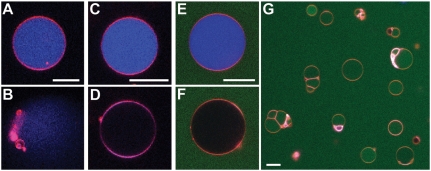Fig. 1.
Mechanism of membrane permeation depends on peptide sequence. (A and B) R6 (unlabeled) added to 20/60/20 PS/PE/PC GUVs (red) with encapsulated Alexa Fluor 633 dye (blue) induced permeation fast enough to rupture vesicles. (C and D) Addition of a single tryptophan hydrophobic residue drastically changed the dominant mode of translocation/escape: R6W (unlabeled) induced slow leakage of intact vesicles, similar to antimicrobial peptides. (E and F) Labeling R6 with the hydrophobic aromatic rings of fluorescein isothiocyanate (FITC, green) also gave rise to slow leakage of encapsulated dye, followed by eventual equilibrium distribution of the R6-FITC peptide (G). White scale bars are 20 μm.

